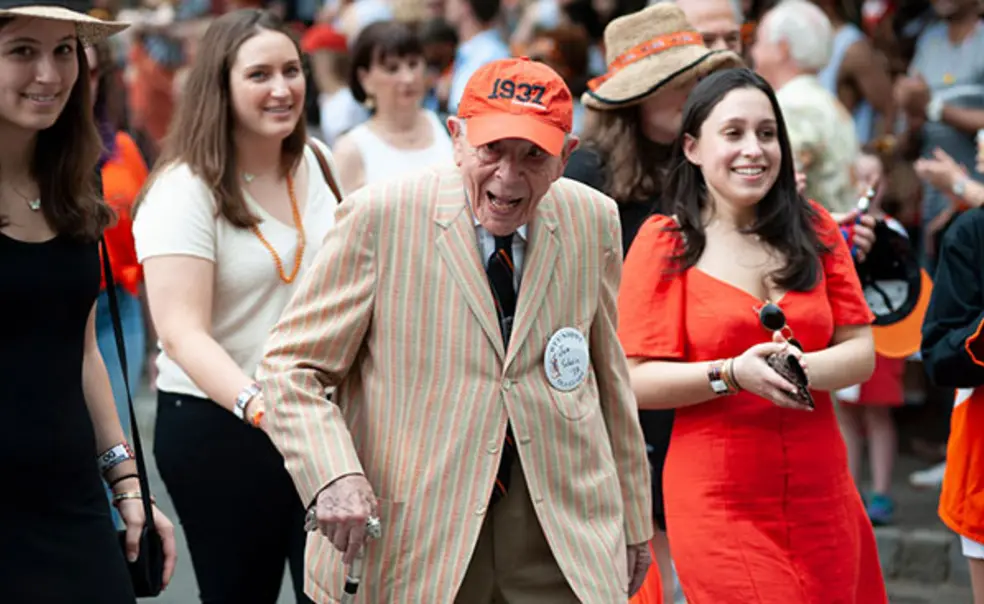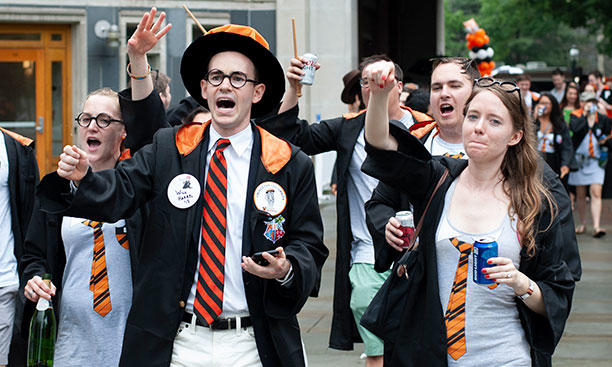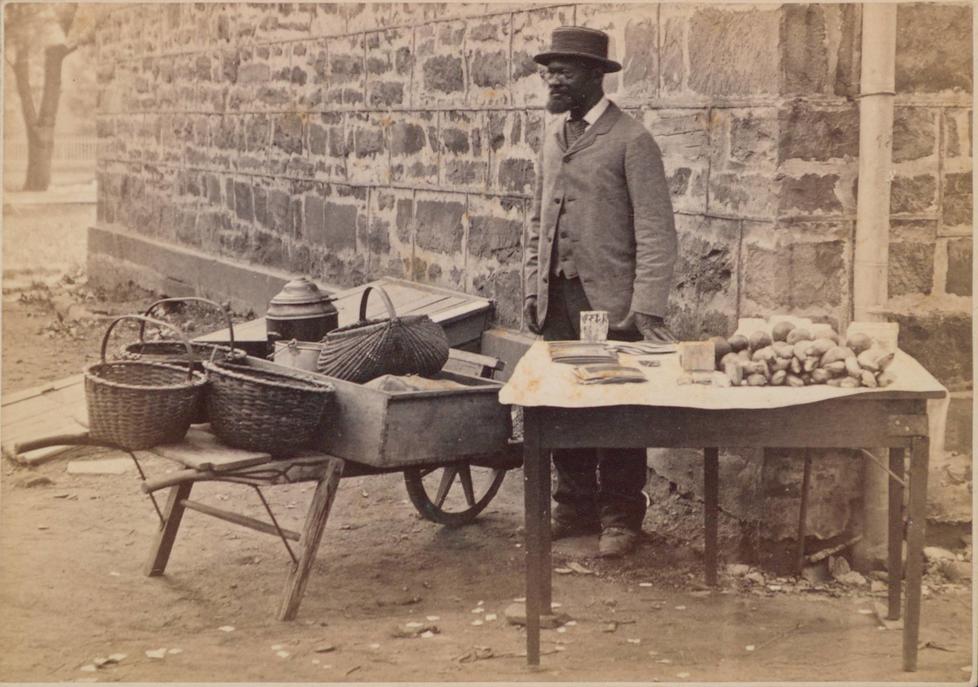“Life moves pretty fast. If you don’t stop and look around once in a while, you could miss it.”
— Ferris Bueller, 1986
One dangerous part of learning history from history books is that they need to be organized and theme-focused before they can be published. This is not wrong in itself, but I suspect we often fall into the trap of assuming that is history; that history somehow happens in an orderly, readily identifiable way.
Actually, some days the sun shines brightly; other days, the clouds, rain, and lightning are all over the place. And while we have notably improved weather forecasting in the last few years, history forecasting doesn’t work quite the same way. I had a nice plan for this column, to leave you with a number of rich ambiguities to chew on over your summer revivification, but then life happened, as Ferris would put it.
Regarding Reunions, I was going to again note the wonderful Class of 1923 Cane winner Dr. Joe Schein ’37, now one of only three alums ever to return to the P-rade 81 years after his commencement — Arthur Holden 1912 and Malcolm Warnock ’25 were the others — then, having told his story before, move smartly to new iconography efforts underway around the campus, and consider their meaning.
This, however, was not a Reunions that could be so nicely contained. I should have suspected beforehand, when two premonitions occurred. First, for a number of logistic and symbolic reasons, plus a great deal of admirable style, the 25th reunion Class of 1993 offered to yield its place at the head of the P-rade to the Old Guard, led of course by Schein. This was a change only in the sense that the Battle of Princeton changed the American Revolution. Second, a Reunions theme that aficionados had waited years to see finally appeared: “Misch13f Managed,” the Harry Potter reunion of the fifth-reunion Class of 2013, complete with Harry’s telltale lightning-bolt scar on their foreheads. Whether Princeton, the real Hogwarts, would be overwhelmed by 27-year-old Gryffindors and/or Slytherins was an intriguing subplot.
And this is where history intervenes. First, the P-rade of 1953 was the only one ever rained out before it began. The 25th-reunion Class of 1928 somehow, late on Saturday, found the Princeton Band lurking, grabbed them, laid siege to Prospect, forced President Harold Dodds *1914 out, then marched with them through 1879 Arch to University Field and around it in the residual rain and muck. And second, the P-rade of 2005, which went smoothly until a sudden downpour with lightning hit just as the first-reunion class cleared the field, and the seniors, only the seniors, were left waiting. Taking an unwitting page from ’28’s playbook, ’05 and Tiger Band proceeded after a few minutes to body surf across submerged and empty Poe Field, still under alert as the storm roared ominously overhead. I wrote a public letter to ’05 in PAW castigating them for their dangerous behavior, paired with a private letter alongside congratulating them for finding real class spirit in the teeth of danger. Some days the sun shines brightly; other days, the clouds, rain, and lightning are all over the place.
And you just know where this is going, right? This year’s P-rade, so long in the planning, ’93’s sole chance to lead, ’53’s last before joining the Old Guard, made it for 45 minutes before lightning flashed and University Public Safety shut it down and sent everyone into buildings. While waiting, there was a short downpour and then lightning less than two miles from campus; this was not imaginary. It became apparent many otherwise educated attendees had no idea what to do, sometimes even after being told; people clustered in reunion tents and had to be shooed into fixed, grounded structures.
After an hour, it was obvious the march could never re-form, for which there was no contingency plan anyway, and the P-rade was canceled. With the alert still on but the rain abated, fragments of younger classes started to appear on abandoned Poe Field. And the first class banner to appear in Bloomberg Arch was — you can’t make this up — the Class of 2005, our old body-surfing buddies, now 35 years old but ever game. With 2018, 2017, and other younger alums milling around and exposed, the grand marshal greenlighted the singing of “Old Nassau” in the hope that would symbolically end things and clear the field, and the PA system was shut down for good. In a final burst of irony, the all-clear was given 15 minutes later. A number of classes, including the lightning-bolt bedecked ’13, made their way to Poe for an impromptu mutual-admiration session thereafter.
The Old Guard made it through to the end before the alert, but miraculously only because ’93 had graciously offered its spot; last year, they never would have gotten near Poe Field. In turn, only the vanguard of ’93 made it through the Bloomberg Arch; most were stuck mid-route. It is highly unlikely that so many of its members will ever again assemble for a P-rade.It doesn’t seem so as it’s happening, of course, but for decades alums will talk about the P-rade of 2018 the same way they do 2005 and even, in more hushed tones, the non-P-rade of 1953. And you must admit, the idea of the Class of 1953, the only senior class not to see a P-rade and be welcomed by fellow alumni, waiting 65 years for its last march prior to joining the Old Guard, only to have its 80 returnees closed down en route and waxed again, is downright spooky. They were 26-1 in three years of varsity football, they include in their number six Princeton trustees, they sent a classmate to the moon; how they also somehow offended the Reunions gods is the type of debate that keeps historians in pocket change. Some days, the sun shines brightly; other days, the clouds, rain, and lightning are all over the place.
History as a cacophonous mixed blessing is, I would suspect, something that would resonate with Betsey Stockton and Jimmy Johnson. Both were born black slaves, she in 1798, he in 1816, and by dint of many adventures they became respected citizens of Princeton in the 19th century, when the town was already 20 percent black. They knew turbulent times. Stockton as a slave was rented out by her owner, Ashbel Green 1783 (who as president almost destroyed the College from 1812-22, but did in the end free her). She later underwent harrowing dangers as a missionary to Hawaii before returning to town. Johnson escaped his owners in Maryland, then ended up a servant at the College. He was ratted out by an alumnus in town, and the court ordered him returned to his (presumably very displeased) owner.
But each persevered, to an astonishing degree. Stockton was the only black person listed as a teacher on the 1860 Princeton census; she founded and ran the town’s black elementary school, all that the gentry would allow, and ran it superbly. She also was co-founder of the Witherspoon Street Presbyterian Church in 1840, and a bulwark of the black religious community. Johnson was liberated by a $550 purchase of his freedom by an abolitionist friend of the College; he then advanced from College employee to entrepreneur, staked by $100 in gifts from the sympathetic students; he repaid both gifts. In his role as food vendor on campus he became, in reality, a resident confidant of his student charges. When Betsey Stockton died in 1865, College president and savior John Maclean Jr. 1816 conducted the service at the Witherspoon Street church; he had been its sponsor at the New Brunswick presbytery when she began it. When Johnson died in 1902, his many alumni admirers paid for his burial in Princeton Cemetery, nearby other great Americans, and for his headstone that reads simply “The Students Friend.”
The University has decided to name a new, elevated park over Firestone Library on Nassau Street for Betsey Stockton, within view of Witherspoon Street, where she started her school and where her church lives on, including a window from her students, dedicated to her. And we will name the eastern archway of East Pyne, near where Jimmy Johnson offered treats for sale and friendship for free, in his honor. It overlooks the great Chapel, donated by the alumni body that created his memorial as well. In which sanctuary the senior Class of 2018, weathered out of its P-rade the day prior, completed its sunny Sunday Baccalaureate service singing Henry van Dyke Jr.’s words:
Mortals, join the mighty chorus
Which the morning stars began.
Boundless love is reigning o’er us,
Reconciling race and clan.
Ever singing, move we forward,
Faithful in the midst of strife,
Joyful music leads us onward
In the triumph song of life.
Some days, the clouds, rain, and lightning are all over the place; but other days, the great days, the great days we must strive for, the sun shines brightly.
Dei sub numine viget.
Is it really summer again? You can ask the ebullient Class of 2018 on their way out of town, or the new Class of 2022 madly packing for their rendezvous with destiny in September; they sure think so. Or you can reboot this year’s reflections in Rally ’Round the Cannon and write an essay on your favorite column — remember the essay must be longer than the source material — then email us the results absolutely free! But wait, there’s more! You can check out the 2018 Pre-read, Professor Keith Whittington’s Speak Freely: Why Universities Must Defend Free Speech, which addresses an existential topic in higher education in this or any year. Vacation well spent.
And pass the piña coladas, see you in September.














No responses yet